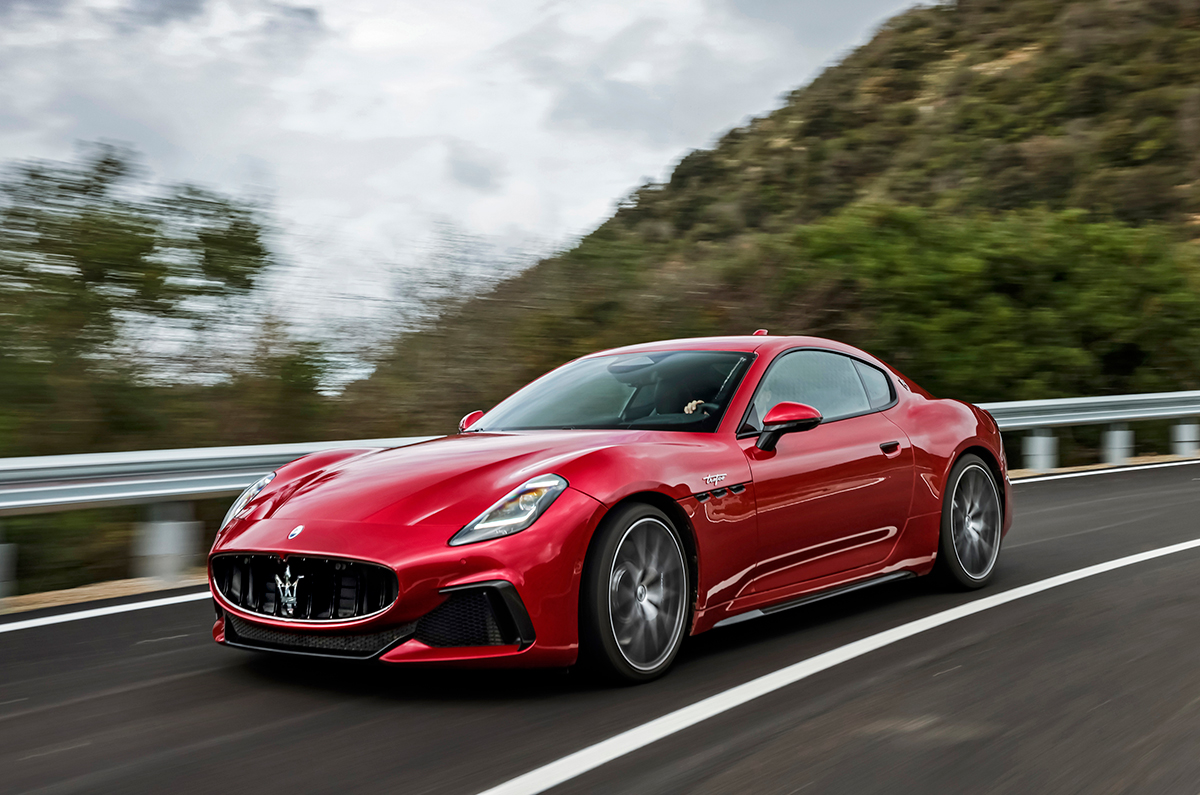
2007 is when the Maserati GranTurismo first arrived, so it's been a mighty long wait for its replacement. But the new GT is finally here and taking a leaf out of the 911 playbook, looks much like its predecessor. But who’s complaining? Look at it, it's gorgeous and exciting too, because underneath that familiar skin, there's a whole lot that's new. Petrol power is courtesy the Nettuno V6 while the V8 is no more, there's an all-electric model – the Folgore – the previous GT’s rear drive set-up is now all-wheel drive, and on all variants, the interior is all new and there’s loads of new tech as well.
Clearly, Maserati has thrown a lot at the new GT, as they should. It forms a key piece of the brand’s recently announced global revival plan comprising hybrids, all electrics, the MC20 supercar and the Grecale SUV. So what’s the new GT like?
Maserati GT: exterior design
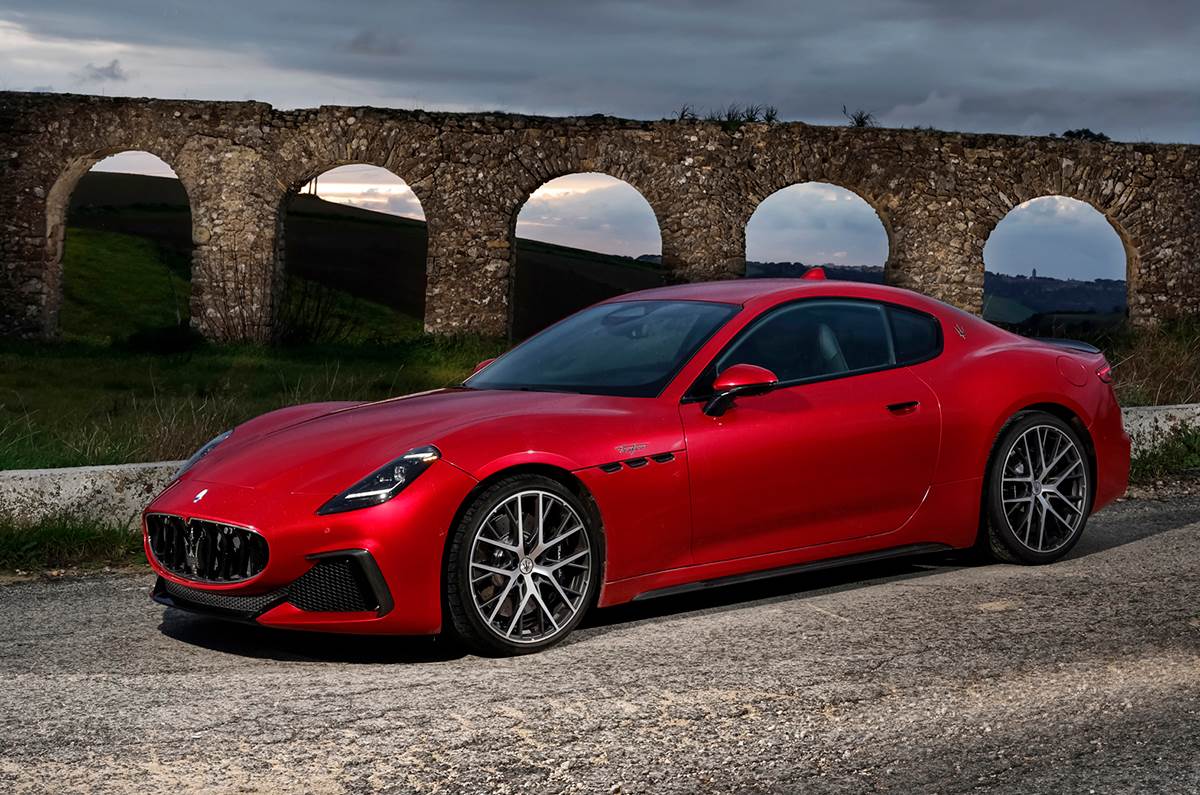 Looks much like its predecessor and that’s good since it’s gorgeous.
Looks much like its predecessor and that’s good since it’s gorgeous.
Though the new GT looks much like the original, seeing it in the flesh, you can tell it’s new. The biggest difference is the headlights, they sit vertically instead of horizontally like before, and they carry the interior styling signature from the MC20; circular projectors sandwiched by an upturned LED bar below and a small LED segment atop.
Thankfully, like the ICE versions, the EV too has a traditional grille sporting a large Trident emblem, no blanked-off panel here. Maserati says it wanted a clean break-free bonnet and it’s executed brilliantly by integrating much of what would be the fenders into one massive bonnet that droops over to the sides and has really beautifully arched shoulders.
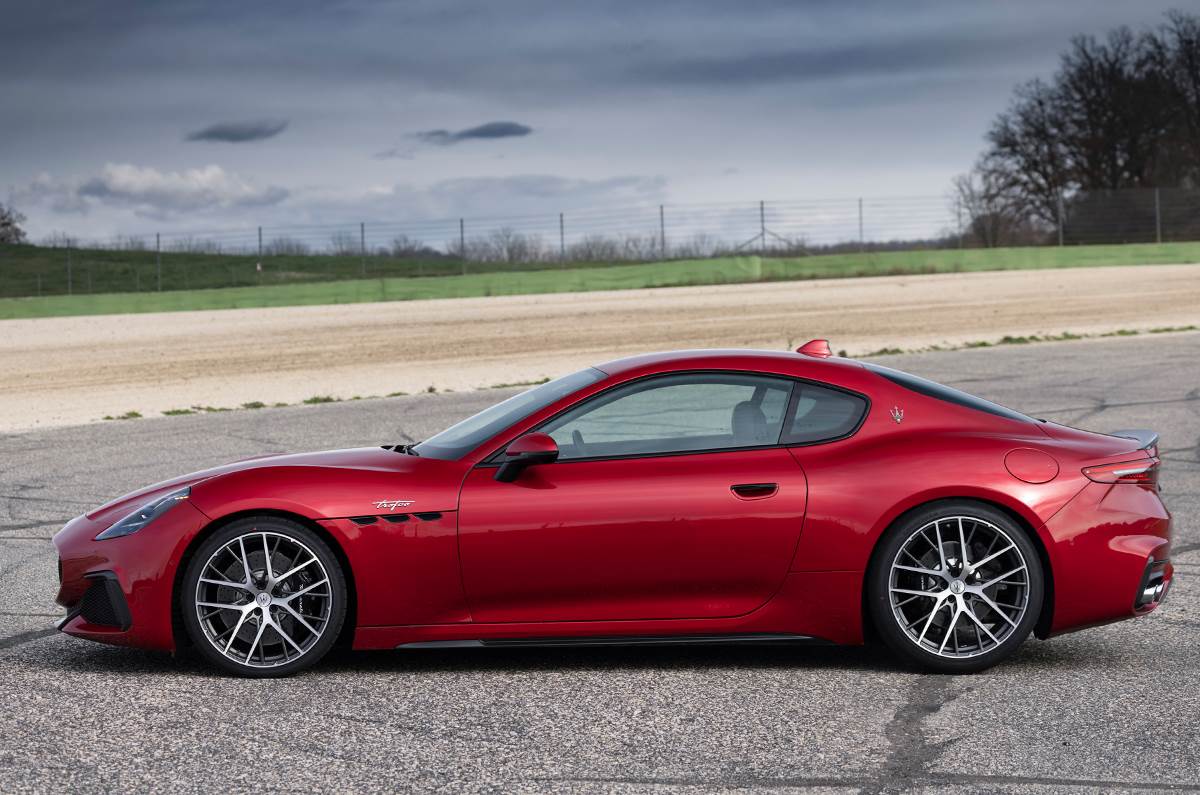 Classic elongated GT stance elegantly done; signature three fender vents are retained.
Classic elongated GT stance elegantly done; signature three fender vents are retained.
At the side, you can really appreciate the long bonnet and elongated stance that’s typical of GTs, and here it’s elegantly drawn out with the car rising and dipping in such a smooth style. Maserati’s signature three fender vents are naturally present and on the Folgore they are illuminated. The Folgore can also be differentiated by wheels styled to aid aero efficiency. The axle-to-dashboard length is quite large, further accentuating the long bonnet look, it’s done to mount the engine behind the front axle, which aids a near-even 52:48 front-rear weight distribution, better crash safety and, of course, it also enabled Maserati designers to sculpt that curvaceous bonnet top.
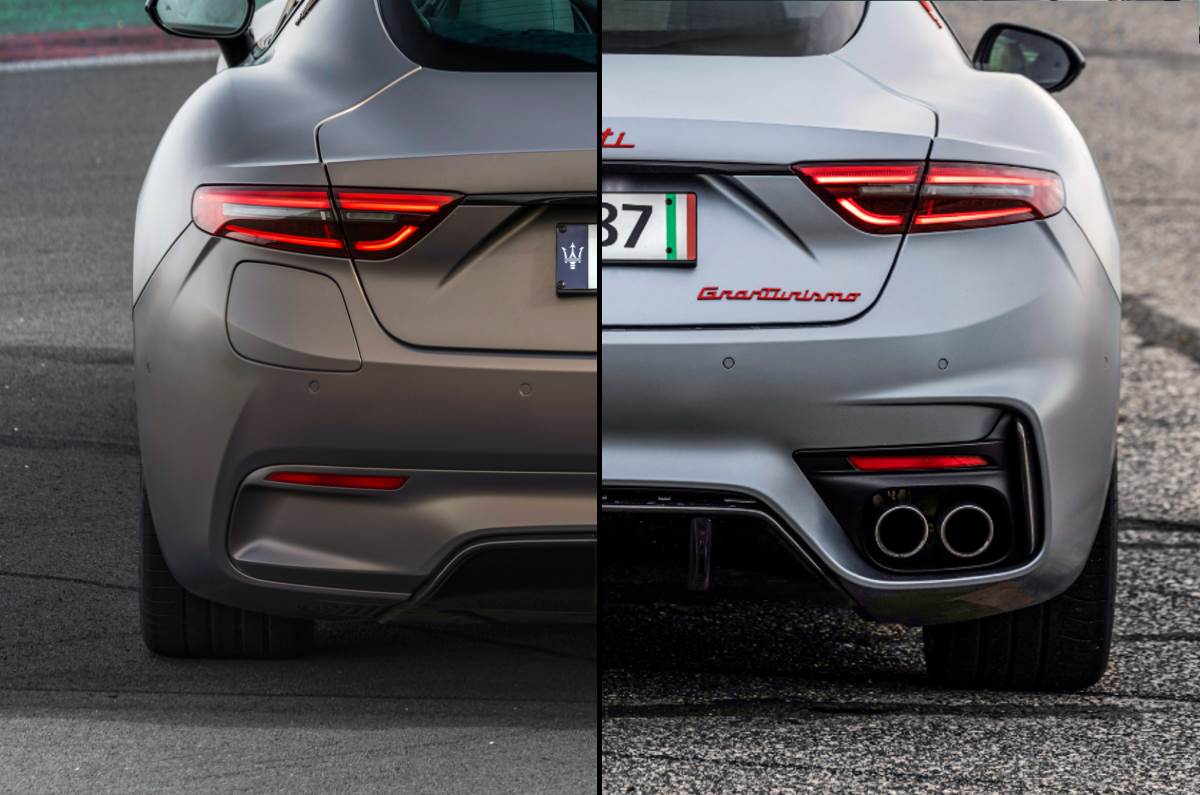 ICE and EV bodies are identical except for missing tail pipes on the EV.
ICE and EV bodies are identical except for missing tail pipes on the EV.
At the rear too, the lines are neat and clean and the boot lid flows neatly into a small lip spoiler and the tail-lights are sleek horizontal units. On the electric version, there’s a large charging flap on the rear fender and naturally missing tailpipes. In their place, however, behind the bumper are two large speakers which create a motor sound. It’s artificial, but at least it doesn’t sound like the washing machine on the dry cycle when you belt the Folgore.
Maserati GT: interior, features, battery set-up
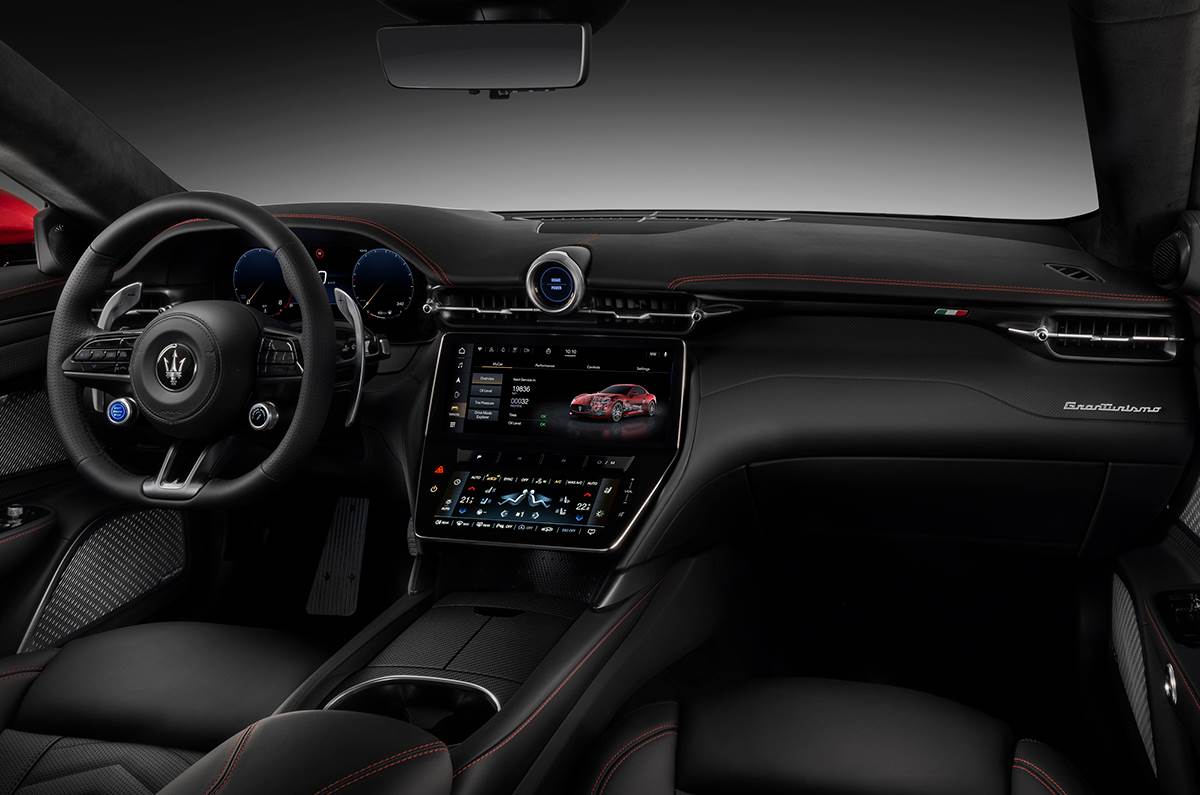 Dashboard looks and feels premium, twin centre screens now replace buttons and dials.
Dashboard looks and feels premium, twin centre screens now replace buttons and dials.
If the outsides are familiar, the insides are certainly not. Three digital screens – 12.3-inch central, 8.8-inch HVAC and 12.2-inch IP – announce the GT’s modernity as does a central digital clock that replaces the older analogue one. For the HVAC and clock though I would have preferred an analogue set-up.
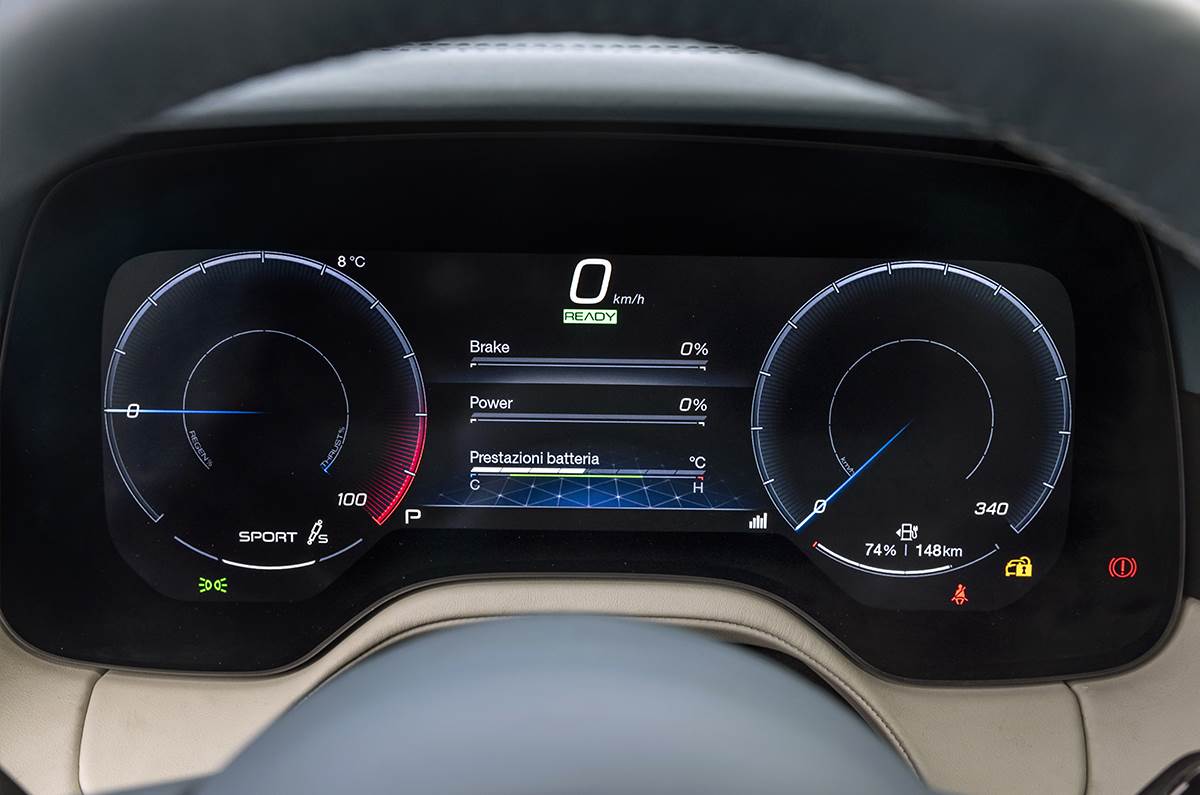 Instrument panel is a 12.2-inch digital screen, thankfully with a twin dial display.
Instrument panel is a 12.2-inch digital screen, thankfully with a twin dial display.
The dashboard is sculpted beautifully and the materials are rich and luxurious, many of them made from recycled materials like old nylon fishing nets. The steering-mounted switches, however, do look cheap and like they are borrowed from another car, which they probably are. The upholstery on the dash and seats has a nice vivid pattern that’s actually laser etched and on the seats, it reveals a contrasting shade below.
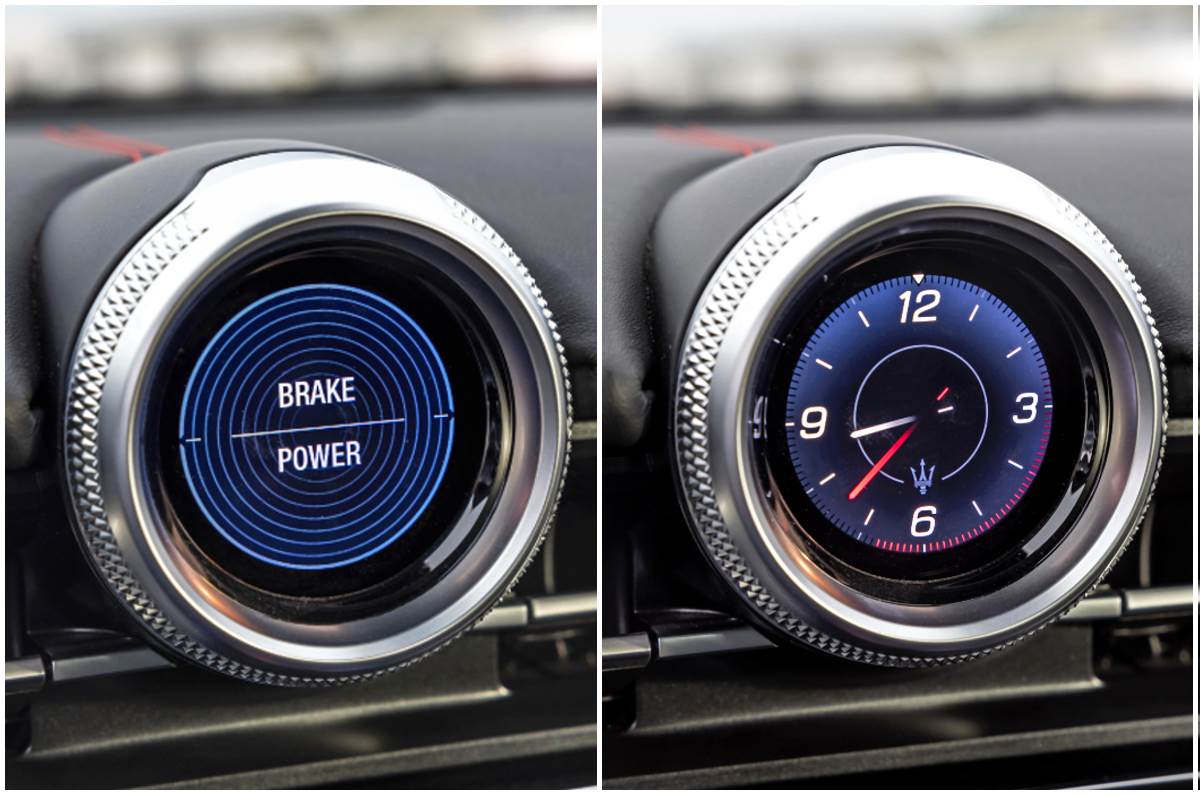 Sadly screen replaces traditional analogue clock but it can display a variety of information.
Sadly screen replaces traditional analogue clock but it can display a variety of information.
Both ICE and EV versions lack a gear lever or a selector dial, but there’s a bank of buttons between the two screens that you poke at to select drive direction. It’s not elegant or engaging, but it has allowed for a bank of small cubby holes and spaces along the centre tunnel.
After a day with the GT, I can also say the seats are comfy and there’s ample space inside, especially the headroom which is good, even more so when you consider this is a low-slung car. Interestingly, headroom and seating position on both ICE and EV are identical and that’s because of the trick battery set-up.
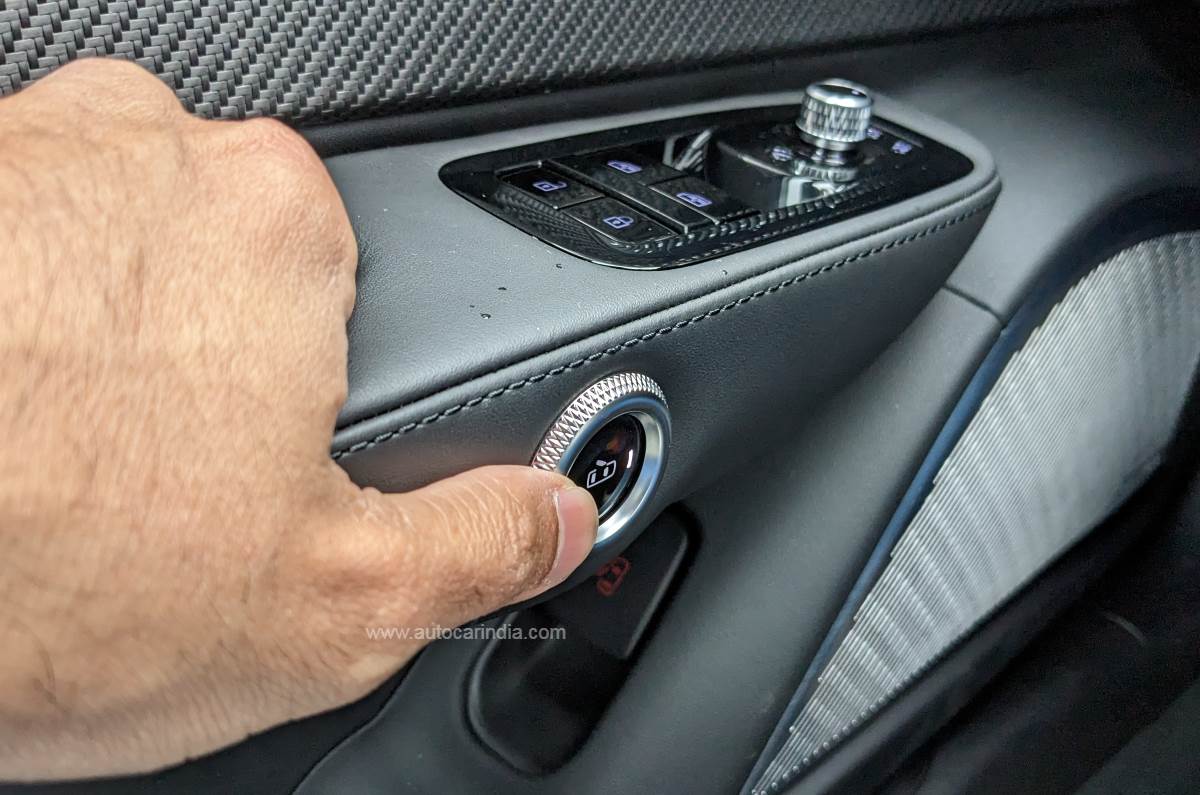 Door handle now an electric button that you push along with the door to open.
Door handle now an electric button that you push along with the door to open.
Beneath the floor, between the front and rear axle is typically where an EV’s battery would be. For many though, this results in a higher passenger-seating position. For the GT, this would not do and Maserati wanted the low driving position identical in both ICE and EV versions.
Thus, it has cleverly moulded the battery pack all along the centre tunnel and into the area where the fuel tank would be, resembling an inverted letter T. Look closely and you’ll see they’ve even arranged the cells to curve the pack around rear passenger’s glutes. The result is seating positions that are identical in both ICE and EV GT as is also the centre of gravity.
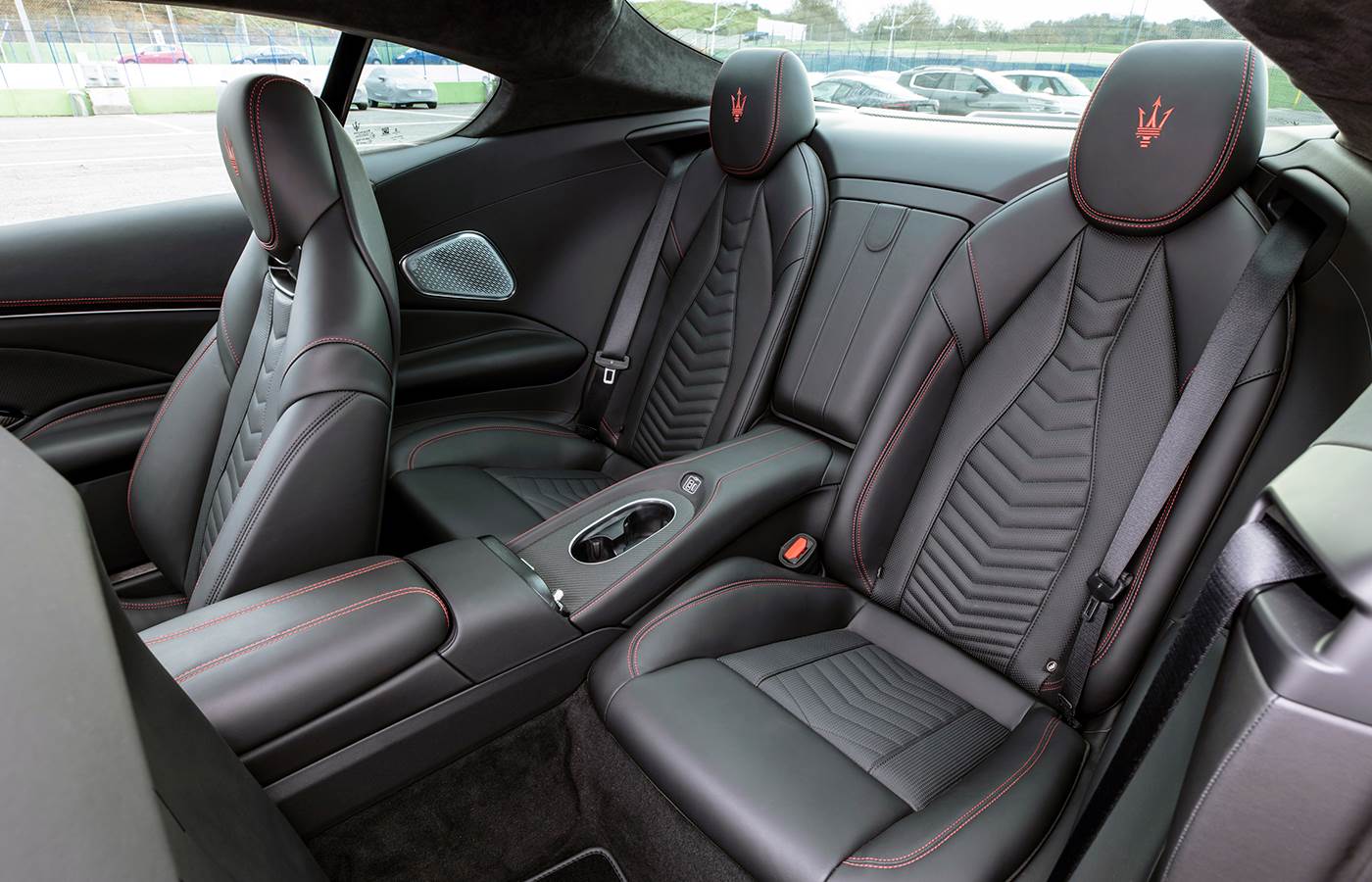 Rear is snug but there is surprisingly good headroom.
Rear is snug but there is surprisingly good headroom.
There is a packaging difference and that’s at the rear. To accommodate the Folgore’s two rear motors, the boot floor is raised, reducing boot space from 310 litres to 270 litres. You don’t gain this via a frunk too as that space is taken up by the front motor and controller. Windshield washer fluid is topped up via a small hatch beneath the windscreen and with no other service points, the Folgore bonnet does not even open. All the best explaining that to hotel security.
There’s a lot of other modern bits too – an electric door release, an HUD, a rear view mirror that you can also flick into a camera feed, connected car tech and a ‘Hey Maserati’ on-board assistant.
Maserati GT: engine and performance
Petrol power comes via Maserati’s Nettuno V6. In case you aren’t familiar, the Nettuno is the company’s first engine produced in-house in more than 20 years. The 3.0-litre twin-turbo engines are built at the new Maserati Engine Lab in Modena and use a lot of innovative tech derived from Formula 1.
The 90-degree-banked cylinders each feature a pre-combustion chamber with a spark plug, in addition to the one in the main chamber. There’s a dual injection system where fuel can be fed into both chambers and the twin spark plugs allow each to be fired separately. Maserati says this improves engine response, reduces emissions and allows for a massive amount of power from a smaller capacity.
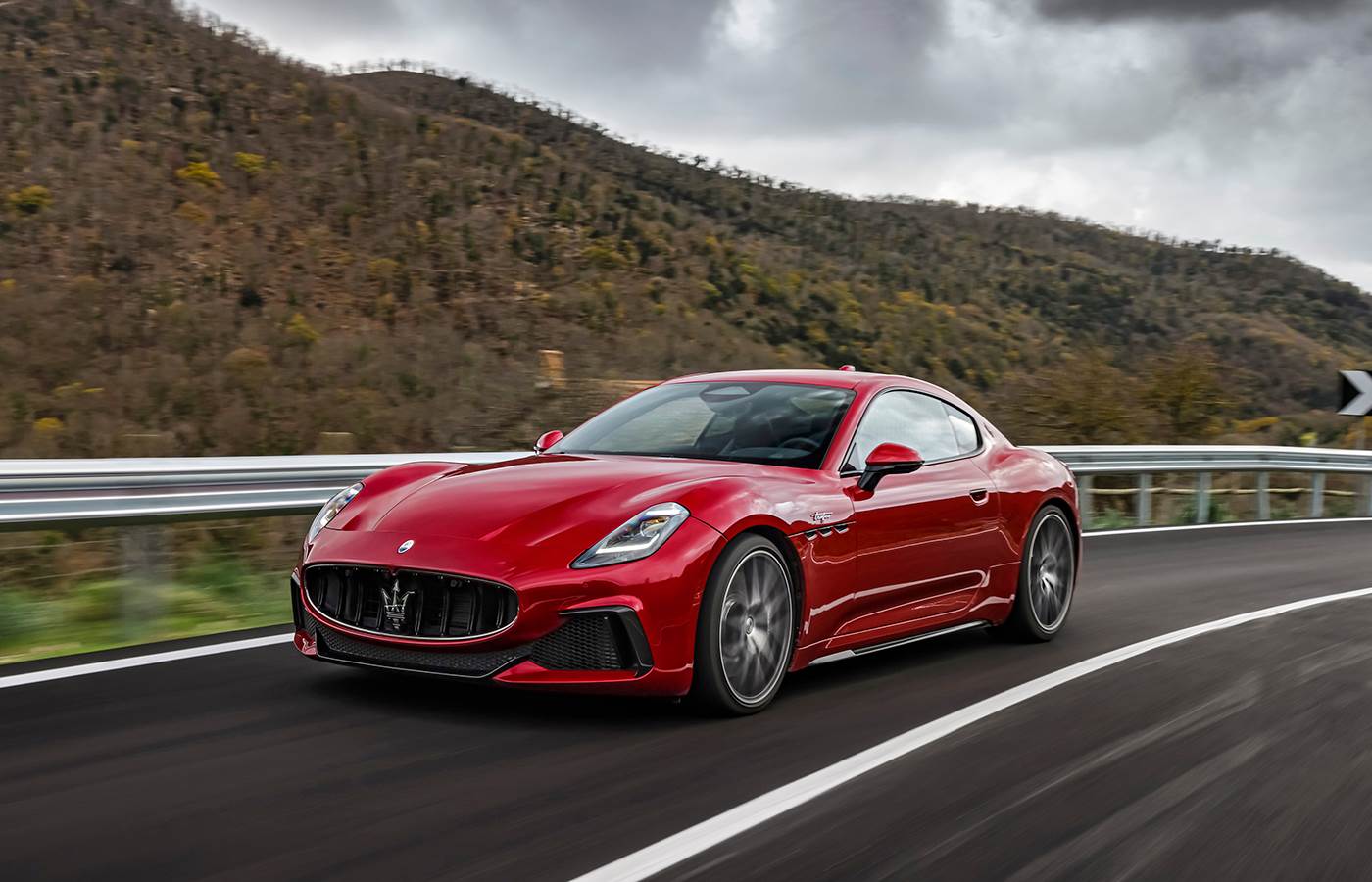 V8 is no more but the Nettuno V6 makes the new GT faster than before.
V8 is no more but the Nettuno V6 makes the new GT faster than before.
In the MC20, there’s a massive 630hp here; on the GT, it’s lower and offered in two states of tune, but still plenty. The Modena puts out 490hp and the Trofeo makes 550hp, and while the V8 is no more, both engine tunes make the new GT faster than before. The Modena does the 0 to 100kph dash in 3.9 seconds and has a top speed of 302kph while the Trofeo takes 3.5 seconds and maxes out at 320kph.
Of the two, we drove the Trofeo and, boy, it is quick! Hit the throttle in Sport and Corsa mode and the GT punches forward rapidly; I didn’t use the latter often though, given that it dials down the ESP and we were driving in a very wet and cold Rome. The 8-speed gearbox goes through the ratios smoothly, and in manual mode offers you a very good degree of influence. The powertrain is also nice and vocal, though this is more exhaust than engine sound, you will miss the V8 here.
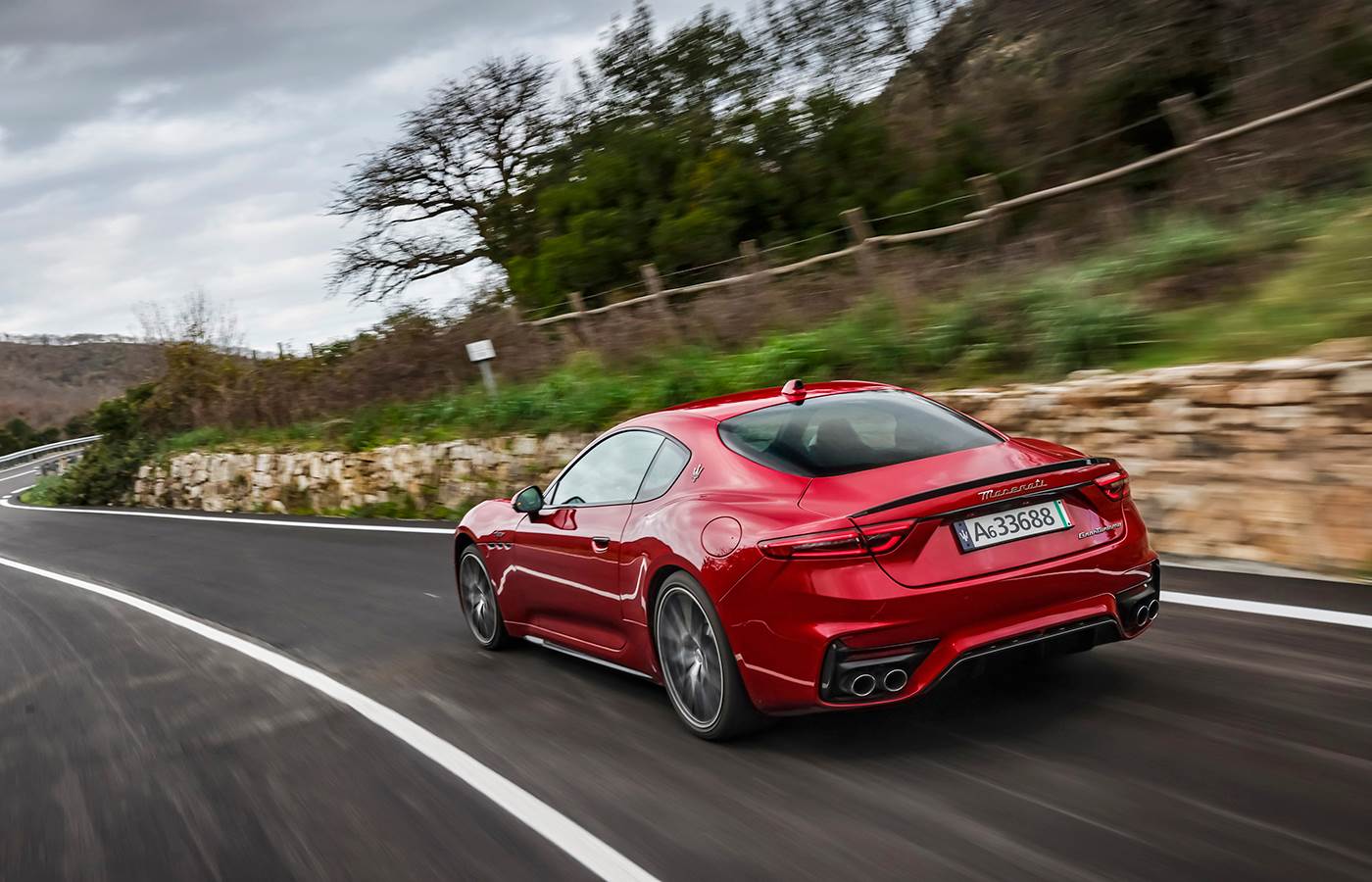 Good ride on smooth surfaces but it should be more compliant over bad roads.
Good ride on smooth surfaces but it should be more compliant over bad roads.
There’s also GT mode for some long-legged cruising, but you lose that immediateness in the throttle response, so it’s really best for steady high-speed cruising and I’d emphasise high speed, as otherwise, the engine sounds clattery and unrefined like it’s grumbling about how slow you’re driving.
Maserati GT: battery, motor and performance
 Controller and motor leave no space for a frunk; on production car the bonnet will not even open.
Controller and motor leave no space for a frunk; on production car the bonnet will not even open.
Top of the performance charts is the Folgore whose three electric motors (two rear, one front) put out a colossal 1,200hp. But there’s a catch, the 92.5 kWh battery can only discharge at a rate fast enough to support 761 of them. We drove at the Vallelunga race track and I can tell you that’s plenty; mash down on the throttle and the Folgore bolts off instantly.
It’s like a light bulb coming on at the flick of a switch. 0 to 100kph comes up in 2.7 seconds, which is simply insane for a GT, that’s proper supercar territory. But that’s what you get from electric drivetrains these days and the Folgore’s is no different.
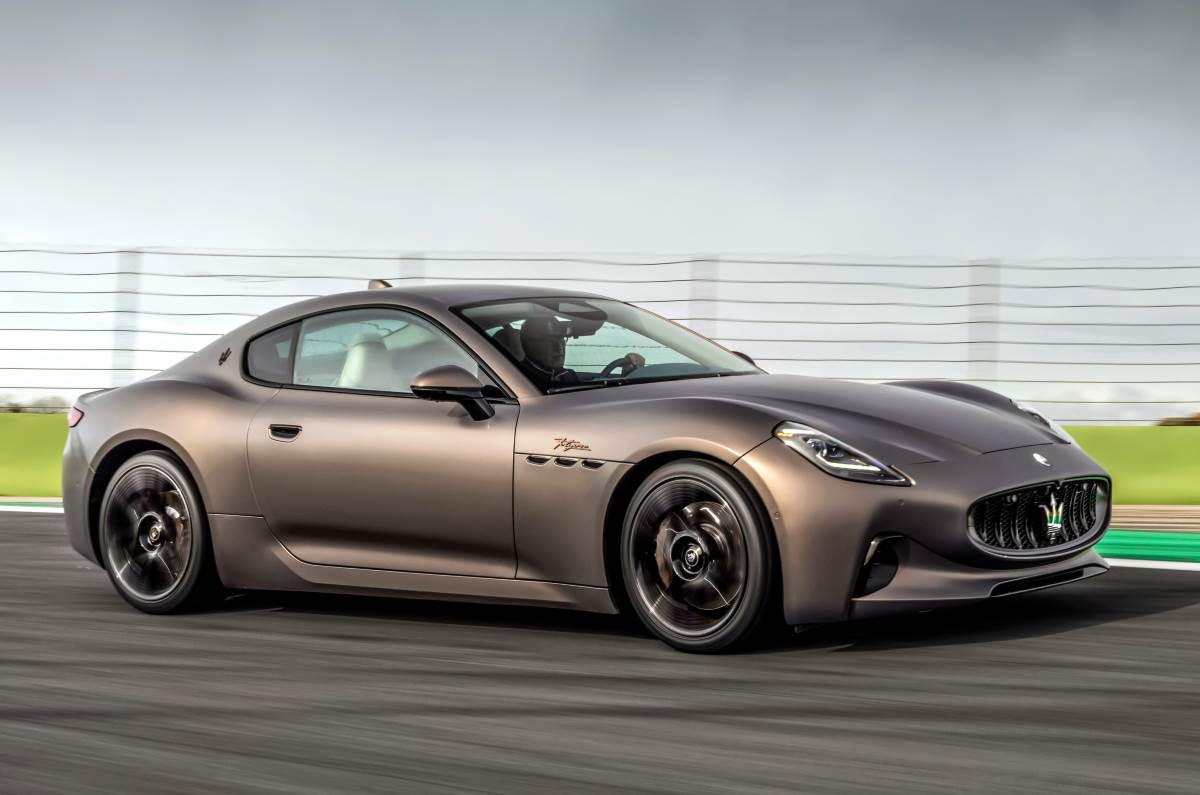 Mash the throttle and acceleration comes instantly, it’s like switching on a light bulb.
Mash the throttle and acceleration comes instantly, it’s like switching on a light bulb.
What’s nice is that acceleration does not taper off soon, at least not until the 200kph mark. We couldn’t get anywhere close to the claimed 325kph top speed at the wet and cold Vallelunga, which also had chicanes added to prevent any of the media from crashing out.
There’s artificial motor sound on board the GT piped both inside and out, and while I don’t like the concept, it ensures that when you belt the Folgore, it doesn’t sound like a washing machine on a dry cycle, do that to a high-performance EV, especially on a wet or slippery surface and that’s what they sound like.
Maserati GT: ride and handling
Performance of both petrol and electric GT is very satisfying and the cars are plenty quick but not so much on broken roads. Outside Rome, we had a lot of bad stretches and the ride was too lumpy and rumbly for what is a GT that too with air springs. The suspension also gets quite audible inside, which only adds to the impression.
The handling though is super, all GTs have AWD standard and as the expected grip is good. It’s rear biased but can distribute its power around with up to 30 percent to the front for improved handling grip. Furthermore, the GTs are also naturally well balanced, the Folgore has a perfect 50:50 front-rear weight distribution and even on the petrol cars, it’s very close at 52:48.
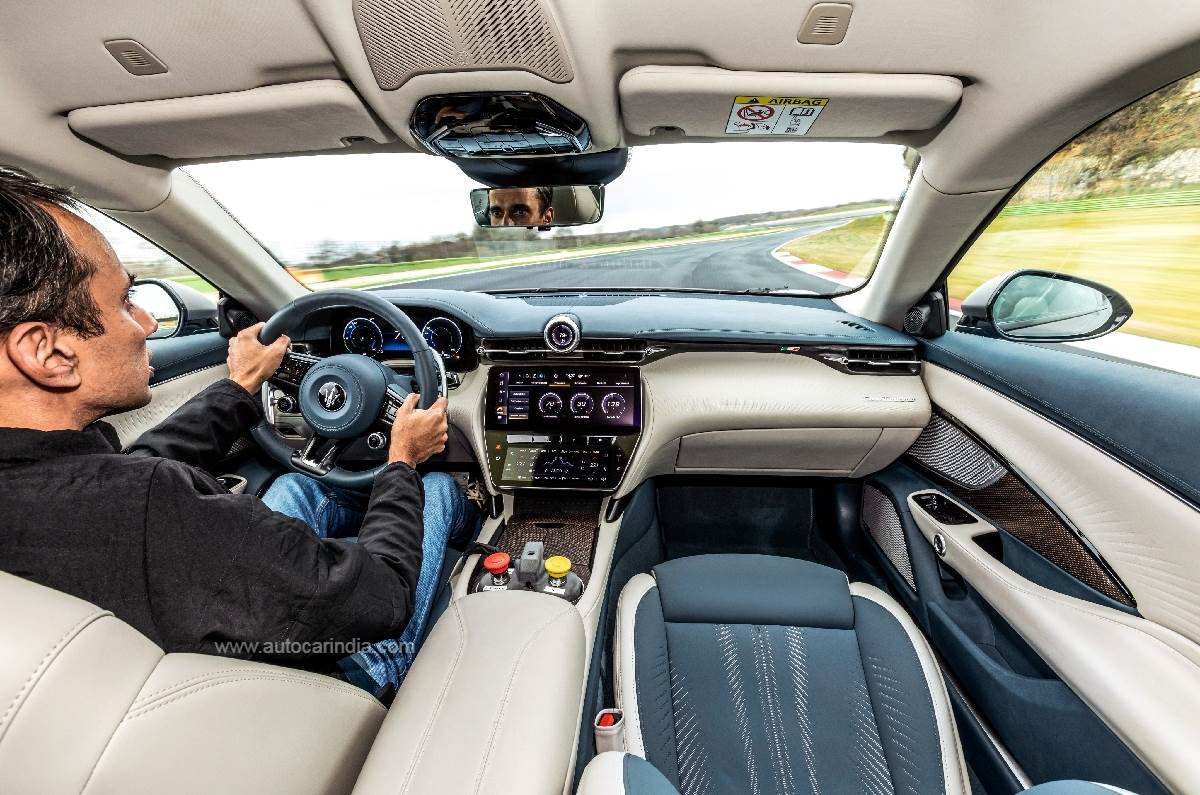 ICE and EV have identical centre of gravity and handle brilliantly; emergency red and yellow buttons only on test car.
ICE and EV have identical centre of gravity and handle brilliantly; emergency red and yellow buttons only on test car.
Thanks to the innovative battery set-up, the Folgore has a centre of gravity that’s identical to the petrol, and with two independent rear motors, torque vectoring is precise and the Folgore corners just as well as its petrol counterpart. The only area where there’s a difference is under braking. The Folgore uses those massive electric motors to harness a lot of power with strong motor braking, however, that, along with the regular friction brakes, doesn’t seem enough in hauling in this over two-tonne GT, not at the track atleast.
Maserati GT: price and verdict
So after a good 16 years, does the new GT live up to expectations? For sure it does. It isn’t perfect, of course, the V6 isn’t as sonorous as the V8, and for a GT, the ride isn’t as compliant as it should have been. Plus, when it does arrive in India, you’ll have to fork over a tidy sum of money, between Rs 2.5 crore to 2.9 crore for the range. But for that money, there’s plenty to tug at your heart strings.
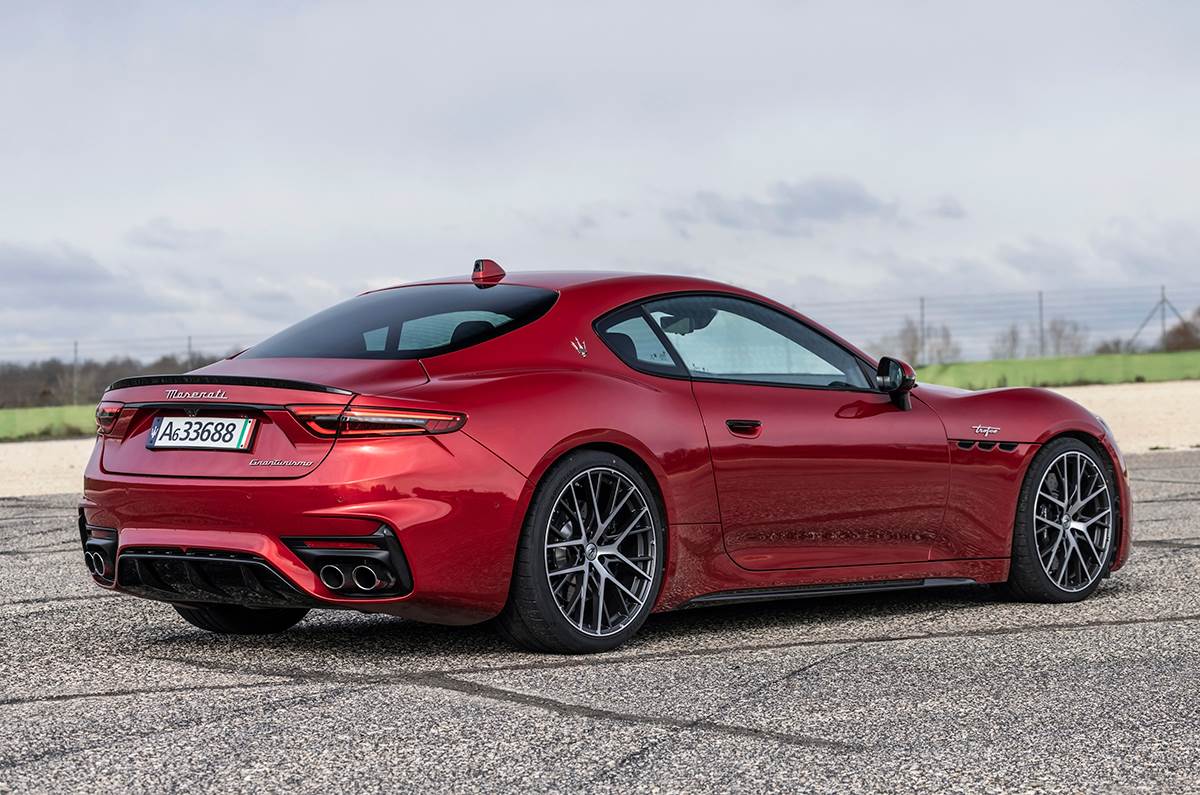
For one, it’s simply drop-dead gorgeous, just like its predecessor and the Nettuno V6 makes it quicker still. The electric drivetrain is simply superb and there’s a host of modern tech inside that comfortable cabin. Maserati has always tried to ride that tricky confluence of luxury and sport, but after a day spent with it, it is safe to say the new GranTurismo does that in style.
Also see:
Maserati GranTurismo video review
from Autocar Indiahttps://cdni.autocarindia.com/ExtraImages/20230215051314_opening.jpg



